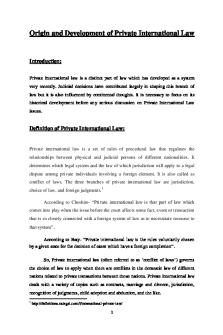Origin and conduction of cardiac impulse notes PDF

| Title | Origin and conduction of cardiac impulse notes |
|---|---|
| Course | Medicine |
| Institution | University of Dundee |
| Pages | 4 |
| File Size | 224 KB |
| File Type | |
| Total Downloads | 23 |
| Total Views | 119 |
Summary
Origin and conduction of cardiac impulse...
Description
Origin and conduction of cardiac impulse HEART Electrically controlled muscular pump that sucks and pumps blood The electrical signals which control the heart are generated within the heart itself The heart can beat rhythmically even in the absence of external stimuli this is called autorhythmicity Where does excitation normally originate? Originates in the sino-atrial node o A group of specialised cells that perform a pacemaker function o Positioned in the right atrium close to the superior vena cava It drives the pace for the whole heart A heart controlled solely by the sino-atrial node is described to be in a sinus rhythm The cells do not have a stable resting potential, they exhibit spontaneous pacemaker potential o Gradual increase of the above allows for action potential to be reached
Ionic basis of pacemaker potential The permeability of K+ does not stay constant between action potentials The slow depolarisation (decrease in negative pacemaker potential) is due to: o Decrease in K+ efflux (Increase +) o Na+ and K+ influx aka “the funny current” (Increase +) o Transient Ca2+ influx via T-type Ca2+ channels o All the above contribute to bringing to action potential threshold Once the threshold has been reached Rapid depolarisation aka the rising phase of action potential due to activation of long lasting L-type Ca2+ channels o This results in a Ca2+ influx Rapid polarisation aka the falling phase o Then deactivation of L-type channels
o Then activation of K+ channels resulting in efflux of K+ o Results in decrease of positive charges
How does excitation normally spread through the heart Cell to cell conduction reaches atrio-ventricular node o Cell-to-cell current proceeds via mainly gap junctions but also intermodal o A slight delay is incurred by the AV node where conduction is slowed This allows atrial systole (contraction of atria) which precedes ventricular systole From AV, excitation spreads to the bundle of His Then bundle splits into right and left branches Right and left branches terminate at the purkinje fibers which are located within the ventricular walls Rapid spread via the above fibers results in excitation of all ventricular myocardium (ventricular systole) The AV node It is the only point of electrical contact between atria and ventricles The action potential of Atrial and Ventricular myocytes The resting membrane potential is -90mV with NO slow depolarisation like pacemaker Fast Na+ influx brings potential to +20mV
The following graph highlights the different phases in ventricular muscle action potential
Phase 0 – rapid influx of Na+ Phase 1 – closure of Na+ channels and transient K+ efflux Phase 2 – Plateau phase (Mainly Ca2+ influx) Phase 3 – Closure of Ca2+ channels and further K+ efflux Phase 4 – return to resting membrane potential
*note the plateau phase is physiologically relevant* How is heart rate modified?
This is mainly done via the autonomic nervous system o Sympathetic branch increases heart rate o Parasympathetic decreases heart rate Via the vagus nerve CN X Exerts a continuous influence on the SA node under resting conditions Vagal nerve stimulation also increases the delay imposed by the AV node Triggered by acetylcholine neurotransmitter via M2 muscarinic receptors Atropine is a competitive inhibitor of acetylcholine, used in extreme bradycardia Normal HR a rest is 60-100 bpm o Less than 60 is bradycardia o Higher than 100 is tachycardia
Vagal stimulation effect on pacemaker potentials cell hyperpolarises resulting in an increase in time taken to reach action potential threshold slope of pacemaker potential decreases effect is a decrease in action potential firing (negative chronotropic effect)
Sympathetic stimulation effect on pacemaker potentials Innervates the SA node and AV node and myocardium Increases heart rate and AV node delay Also, increases the force of contraction Triggered by noradrenaline neurotransmitter via B-1 adrenoceptors o Administering noradrenaline increases slope of pacemaker potential o Positive chronotropic effect...
Similar Free PDFs

Origin and insertions of forearm
- 2 Pages

Impulse and Momentum worksheet
- 2 Pages

Origin of Life - Lecture notes 1
- 19 Pages

Origin-of-Humans
- 4 Pages

Cardiac drugs notes
- 8 Pages

Cardiac - Lecture notes 1
- 23 Pages
Popular Institutions
- Tinajero National High School - Annex
- Politeknik Caltex Riau
- Yokohama City University
- SGT University
- University of Al-Qadisiyah
- Divine Word College of Vigan
- Techniek College Rotterdam
- Universidade de Santiago
- Universiti Teknologi MARA Cawangan Johor Kampus Pasir Gudang
- Poltekkes Kemenkes Yogyakarta
- Baguio City National High School
- Colegio san marcos
- preparatoria uno
- Centro de Bachillerato Tecnológico Industrial y de Servicios No. 107
- Dalian Maritime University
- Quang Trung Secondary School
- Colegio Tecnológico en Informática
- Corporación Regional de Educación Superior
- Grupo CEDVA
- Dar Al Uloom University
- Centro de Estudios Preuniversitarios de la Universidad Nacional de Ingeniería
- 上智大学
- Aakash International School, Nuna Majara
- San Felipe Neri Catholic School
- Kang Chiao International School - New Taipei City
- Misamis Occidental National High School
- Institución Educativa Escuela Normal Juan Ladrilleros
- Kolehiyo ng Pantukan
- Batanes State College
- Instituto Continental
- Sekolah Menengah Kejuruan Kesehatan Kaltara (Tarakan)
- Colegio de La Inmaculada Concepcion - Cebu









